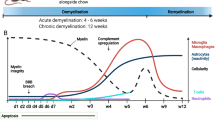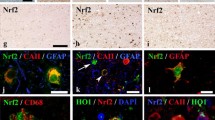Abstract
Oxidative stress is a pathophysiological hallmark of many CNS diseases, among multiple sclerosis (MS). Accordingly, boosting the astrocytic transcription factor nuclear factor E2-related factor 2 (Nrf2) system in an MS mouse model efficiently ameliorates oligodendrocyte loss, neuroinflammation and axonal damage. Moreover, Dimethylfumarate, an efficient activator of Nrf2, has recently been approved as therapeutic option in MS treatment. Here, we use the cuprizone mouse model of MS to induce oxidative stress, selective oligodendrocyte loss, microglia and astrocyte activation as well as axonal damage in both wild type and Nrf2-deficient mice. We found increased oligodendrocyte apoptosis and loss, pronounced neuroinflammation and higher levels of axonal damage in cuprizone-fed Nrf2-deficient animals when compared to wild type controls. In addition, Nrf2-deficient animals showed a higher susceptibility towards cuprizone within the commissura anterior white matter tract, a structure that is relatively insensitive to cuprizone in wild type animals. Our data highlight the cuprizone model as a suitable tool to study the complex interplay of oxidative stress, neuroinflammation and axonal damage. Further studies will have to show whether distinct expression patterns of Nrf2 are involved in the variable susceptibility towards cuprizone in the mouse.





Similar content being viewed by others
References
Al-Sawaf O, Clarner T, Fragoulis A, Kan YW, Pufe T, Streetz K, Wruck CJ (2015) Nrf2 in health and disease: current and future clinical implications. Clin Sci (Lond) 129(12):989–999
Berghoff, SA, Duking T, Spieth L,Winchenbach J, Stumpf SK, Gerndt N, Kusch K, Ruhwedel T, Mobius W and Saher G (2017). Blood-brain barrier hyperpermeability precedes demyelination in the cuprizone model. 5(1): 94
Blesa J, Trigo-Damas I, Quiroga-Varela A, Jackson-Lewis VR (2015) Oxidative stress and Parkinson's disease. Front Neuroanat 9:91–91
Bomprezzi R (2015) Dimethyl fumarate in the treatment of relapsing-remitting multiple sclerosis: an overview. Ther Adv Neurol Disord 8(1):20–30
Bradl M, Lassmann H (2010) Oligodendrocytes: biology and pathology. Acta Neuropathol 119(1):37–53
Canning P, Sorrell FJ, Bullock AN (2015) Structural basis of Keap1 interactions with Nrf2. Free Radic Biol Med 88:101–107
Chan K, Lu R, Chang JC, Kan YW (1996) NRF2, a member of the NFE2 family of transcription factors, is not essential for murine erythropoiesis, growth, and development. Proc Natl Acad Sci U S A 93(24):13943–13948
Clarner T, Diederichs F, Berger K, Denecke B, Gan L, van der Valk P, Beyer C, Amor S, Kipp M (2012) Myelin debris regulates inflammatory responses in an experimental demyelination animal model and multiple sclerosis lesions. Glia 60(10):1468–1480
Dan Dunn J, Alvarez LA, Zhang X, Soldati T (2015) Reactive oxygen species and mitochondria: a nexus of cellular homeostasis. Redox Biol 6:472–485
De AK, Subramanian M (1982) Effect of cuprizone feeding on hepatic superoxide dismutase and cytochrome oxidase activities in mice. Experientia 38(7):784–785
Draheim T, Liessem A, Scheld M, Wilms F, Weissflog M, Denecke B, Kensler TW, Zendedel A, Beyer C, Kipp M, Wruck CJ, Fragoulis A, Clarner T (2016) Activation of the astrocytic Nrf2/ARE system ameliorates the formation of demyelinating lesions in a multiple sclerosis animal model. Glia 64(12):2219–2230
Fenlon LR, Suárez R, Richards LJ (2017) The anatomy, organisation and development of contralateral callosal projections of the mouse somatosensory cortex. Brain Neurosci Adv 1:2398212817694888
Fischbach F, Nedelcu J, Leopold P, Zhan J, Clarner T, Nellessen L, Beissel C, van Heuvel Y, Goswami A, Weis J, Denecke B, Schmitz C, Hochstrasser T, Nyamoya S, Victor M, Beyer C and Kipp M (2019) Cuprizone-induced graded oligodendrocyte vulnerability is regulated by the transcription factor DNA damage-inducible transcript 3. 67(2): 263–276
Fragoulis A, Siegl S, Fendt M, Jansen S, Soppa U, Brandenburg LO, Pufe T, Weis J, Wruck CJ (2017) Oral administration of methysticin improves cognitive deficits in a mouse model of Alzheimer's disease. Redox Biol 12:843–853
Fries M, Mertens M, Teske N, Kipp M, Beyer C, Willms T, Valkonen A, Rissanen K, Albrecht M, Clarner T (2019) Water-soluble Cuprizone derivative: synthesis, characterization, and in vitro studies. ACS Omega 4(1):1685–1689
Gonsette RE (2008) Neurodegeneration in multiple sclerosis: the role of oxidative stress and excitotoxicity. J Neurol Sci 274(1–2):48–53
Hochstrasser T, Exner GL, Nyamoya S, Schmitz C, Kipp M (2017) Cuprizone-containing pellets are less potent to induce consistent demyelination in the Corpus callosum of C57BL/6 mice. J Mol Neurosci 61(4):617–624
Huang W-J, Zhang X, Chen W-W (2016) Role of oxidative stress in Alzheimer's disease. Biomed Rep 4(5):519–522
Jakovac H, Grubic Kezele T, Radosevic-Stasic B (2018) Expression profiles of Metallothionein I/II and Megalin in Cuprizone model of De- and Remyelination. Neuroscience 388:69–86
Juurlink BH (1997) Response of glial cells to ischemia: roles of reactive oxygen species and glutathione. Neurosci Biobehav Rev 21(2):151–166
Karnati S, Luers G, Pfreimer S, Baumgart-Vogt E (2013) Mammalian SOD2 is exclusively located in mitochondria and not present in peroxisomes. Histochem Cell Biol 140(2):105–117
Kashani IR, Chavoshi H, Pasbakhsh P, Hassani M, Omidi A, Mahmoudi R, Beyer C, Zendedel A (2017) Protective effects of erythropoietin against cuprizone-induced oxidative stress and demyelination in the mouse corpus callosum. Iran J Basic Med Sci 20(8):886–893
Katarina V, Gordana T, Svetlana MD and Milica B (2018). Oxidative stress and neuroinflammation should be both considered in the occurrence of fatigue and depression in multiple sclerosis. Acta Neurologica Belgica
Kawamata H, Manfredi G (2010) Import, maturation, and function of SOD1 and its copper chaperone CCS in the mitochondrial intermembrane space. Antioxid Redox Signal 13(9):1375–1384
Lee JM, Li J, Johnson DA, Stein TD, Kraft AD, Calkins MJ, Jakel RJ, Johnson JA (2005) Nrf2, a multi-organ protector? FASEB J 19(9):1061–1066
Lehmann JCU, Listopad JJ, Rentzsch CU, Igney FH, von Bonin A, Hennekes HH, Asadullah K, Docke W-DF (2007) Dimethylfumarate induces immunosuppression via glutathione depletion and subsequent induction of Heme oxygenase 1. J Investig Dermatol 127(4):835–845
Liessem-Schmitz A, Teske N, Scheld M, Nyamoya S, Zendedel A, Beyer C, Clarner T and Fragoulis A (2018). Nrf2 Signaling in Sodium Azide-Treated Oligodendrocytes Restores Mitochondrial Functions. 66(2): 229–237
Lim JL, van der Pol SM, Baron W, McCord JM, de Vries HE, van Horssen J (2016) Protandim protects oligodendrocytes against an oxidative insult. Antioxidants (Basel) 5(3)
Ma Q (2013) Role of nrf2 in oxidative stress and toxicity. Annu Rev Pharmacol Toxicol 53:401–426
Mahad D, Ziabreva I, Lassmann H, Turnbull D (2008) Mitochondrial defects in acute multiple sclerosis lesions. Brain 131(Pt 7):1722–1735
Matsushima GK, Morell P (2001) The neurotoxicant, cuprizone, as a model to study demyelination and remyelination in the central nervous system. Brain Pathol 11(1):107–116
Moharregh-Khiabani D, Blank A, Skripuletz T, Miller E, Kotsiari A, Gudi V, Stangel M (2010) Effects of fumaric acids on cuprizone induced central nervous system de- and remyelination in the mouse. PLoS One 5(7):e11769
Nyamoya S, Leopold P, Becker B, Beyer C, Hustadt F, Schmitz C, Michel A, Kipp M (2018) G-protein-coupled receptor Gpr17 expression in two multiple sclerosis Remyelination models. Neurobiol, Mol
Nystad AE, Torkildsen O, Wergeland S (2018) Effects of vitamin D on axonal damage during de- and remyelination in the cuprizone model. J Neuroimmunol 321:61–65
Omotoso GO, Gbadamosi IT, Afolabi TT, Abdulwahab AB, Akinlolu AA (2018) Ameliorative effects of Moringa on cuprizone-induced memory decline in rat model of multiple sclerosis. Anat Cell Biol 51(2):119–127
Pawate S, Shen Q, Fan F, Bhat NR (2004) Redox regulation of glial inflammatory response to lipopolysaccharide and interferongamma. J Neurosci Res 77(4):540–551
Perry VH (2005) 17 - inflammation and axon degeneration. Academic Press, Multiple Sclerosis As A Neuronal Disease. S. G. Waxman. Burlington, pp 241–253
Piroli GG, Manuel AM, Patel T, Walla MD, Shi L, Lanci SA, Wang J, Galloway A, Ortinski PI and Smith DS (2018). Identification of Novel Protein Targets of Dimethyl Fumarate Modification in Neurons and Astrocytes Reveals Actions Independent of Nrf2 Stabilization.
Ruhling S, Kramer F, Schmutz S, Amor S, Jiangshan Z, Schmitz C, Kipp M and Hochstrasser T (2018) Visualization of the Breakdown of the Axonal Transport Machinery: a Comparative Ultrastructural and Immunohistochemical Approach.
Scheld M, Ruther BJ, Grosse-Veldmann R, Ohl K, Tenbrock K, Dreymuller D, Fallier-Becker P, Zendedel A, Beyer C, Clarner T, Kipp M (2016) Neurodegeneration triggers peripheral immune cell recruitment into the forebrain. J Neurosci 36(4):1410–1415
Scheld M, Fragoulis A, Nyamoya S, Zendedel A, Denecke B, Krauspe B, Teske N, Kipp M, Beyer C, Clarner T (2018) Mitochondrial impairment in Oligodendroglial cells induces cytokine expression and signaling. J Mol Neurosci
Scheld M, Fragoulis A, Nyamoya S, Zendedel A, Denecke B, Krauspe B, Teske N, Kipp M, Beyer C, Clarner T (2019) Mitochondrial impairment in Oligodendroglial cells induces cytokine expression and signaling. J Mol Neurosci 67(2):265–275
Schilling S, Goelz S, Linker R, Luehder F, Gold R (2006) Fumaric acid esters are effective in chronic experimental autoimmune encephalomyelitis and suppress macrophage infiltration. Clin Exp Immunol 145(1):101–107
Siotto M, Filippi MM, Simonelli I, Landi D, Ghazaryan A, Vollaro S, Ventriglia M, Pasqualetti P, Rongioletti MCA, Squitti R, Vernieri F (2019) Oxidative stress related to Iron metabolism in relapsing remitting multiple sclerosis patients with low disability. Front Neurosci 13:86
Solleiro-Villavicencio H, Rivas-Arancibia S (2018) Effect of chronic oxidative stress on Neuroinflammatory response mediated by CD4(+)T cells in neurodegenerative diseases. Front Cell Neurosci 12:114
Taraboletti A, Walker T, Avila R, Huang H, Caporoso J, Manandhar E, Leeper TC, Modarelli DA, Medicetty S, Shriver LP (2017) Cuprizone intoxication induces cell intrinsic alterations in oligodendrocyte metabolism independent of copper chelation. Biochemistry 56(10):1518–1528
Teske N, Liessem A, Fischbach F, Clarner T and Beyer C (2018). Chemical hypoxia-induced integrated stress response activation in oligodendrocytes is mediated by the transcription factor nuclear factor (erythroid-derived 2)-like 2 (NRF2). 144(3): 285–301
Thorburne SK, Juurlink BH (1996) Low glutathione and high iron govern the susceptibility of oligodendroglial precursors to oxidative stress. J Neurochem 67(3):1014–1022
Wruck CJ, Gotz ME, Herdegen T, Varoga D, Brandenburg LO, Pufe T (2008) Kavalactones protect neural cells against amyloid beta peptide-induced neurotoxicity via extracellular signal-regulated kinase 1/2-dependent nuclear factor erythroid 2-related factor 2 activation. Mol Pharmacol 73(6):1785–1795
Zendedel A, Kashani IR, Azimzadeh M, Pasbakhsh P, Omidi N, Golestani A, Beyer C, Clarner T (2016) Regulatory effect of triiodothyronine on brain myelination and astrogliosis after cuprizone-induced demyelination in mice. Metab Brain Dis 31(2):425–433
Zhang DD (2006) Mechanistic studies of the Nrf2-Keap1 signaling pathway. Drug Metab Rev 38(4):769–789
Zhang DD, Lo SC, Cross JV, Templeton DJ, Hannink M (2004) Keap1 is a redox-regulated substrate adaptor protein for a Cul3-dependent ubiquitin ligase complex. Mol Cell Biol 24(24):10941–10953
Zorov DB, Juhaszova M, Sollott SJ (2014) Mitochondrial reactive oxygen species (ROS) and ROS-induced ROS release. Physiol Rev 94(3):909–950
Author information
Authors and Affiliations
Corresponding author
Additional information
Publisher’s note
Springer Nature remains neutral with regard to jurisdictional claims in published maps and institutional affiliations.
Electronic supplementary material
Supplementary figure 1
Comparison of cellular parameters is shown between wild type animals and Nrf2−/− animals in sagittal sliced brains stained against myelin protein PLP, microglia marker Iba1 and astrocyte protein GFAP. Myelination in Nrf2−/− animals was comparable to WT animals and no differences can be observed in between the genotypes regarding cellular density, morphology or numbers of positively stained cells. (PNG 2723 kb)
Rights and permissions
About this article
Cite this article
Nellessen, A., Nyamoya, S., Zendedel, A. et al. Nrf2 deficiency increases oligodendrocyte loss, demyelination, neuroinflammation and axonal damage in an MS animal model. Metab Brain Dis 35, 353–362 (2020). https://doi.org/10.1007/s11011-019-00488-z
Received:
Accepted:
Published:
Issue Date:
DOI: https://doi.org/10.1007/s11011-019-00488-z




